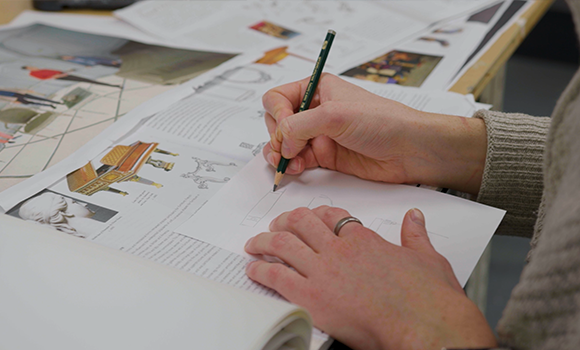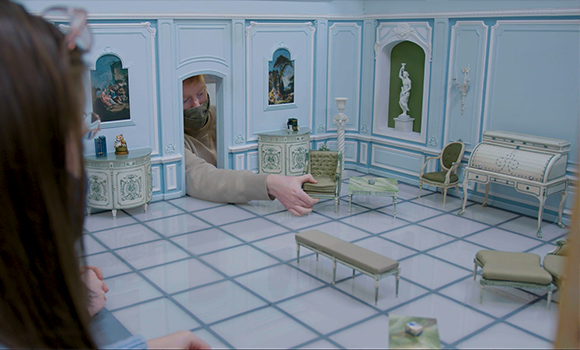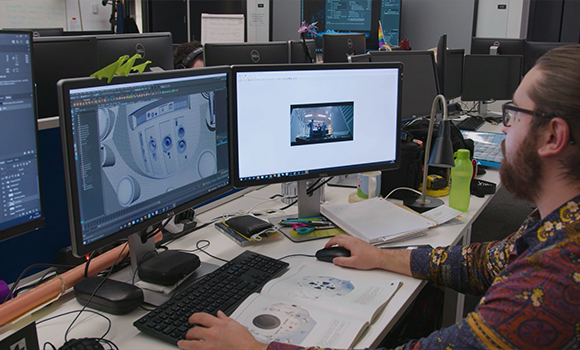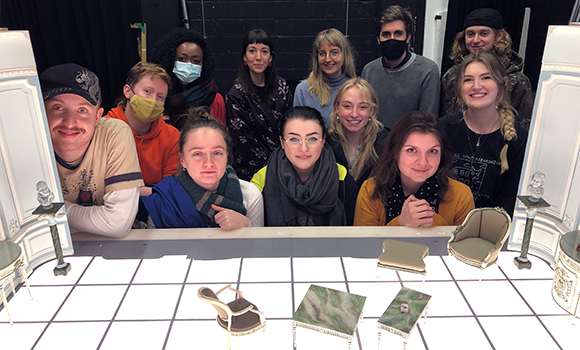2001: A Space Odyssey - An Out of This World Replica Set Build!
The replica set build module on The National Film and Television School (NFTS) Model Making Diploma is the first big collaborative piece of work for the students. Each year they are tasked with recreating a miniature replica of an iconic set from a ground-breaking culturally significant film. This year the students crafted a 1:6 scale replica of a set from 2001: A Space Odyssey, directed by Stanley Kubrick, alongside collaborating with the NFTS Visual Effects MA students!
How The Replica Set Happened
The replica set is 1:6 scale, and came from a suggestion by NFTS graduate model maker Tom Winfield. The idea was that Model Making students at NFTS, overseen by Head of Model Making John Lee, would collaborate with the NFTS Visual Effects MA led by Ian Murphy. In fact, the VFX students would be crafting the same set in Maya so they could add in digital assets to feature in a short sequence involving the replica set.

"This is fabulous. What a fantastic project to work on. Good job all round. Bravo!" - Stanley Kubrick's daughter Katharina, on seeing the students' set build
“To kick things off,” details Lee, “we started at The Kubrick Archive in London, who over the last few years have kindly given access to my students to carry out research on various Kubrick films. This year, we moved over to Zoom for all our research, so I’m grateful for the research staff at the archive who gave my students an overview of just how significant 2001 was, and still is. Legendary model maker Simon Atkinson, who along with his friend and author Piers Bizony were able to share some hi-resolution images from the shooting of the actual film, which significantly helped with scaling some of the detail in the set. Piers is the author of ‘2001 – Filming the Future’, one of the most authoritative books about the making of 2001.”
Lee adds that the aim was for the model to replicate the real set as closely as possible. The final practical model took six weeks to build, with Lee commenting that the bigger challenges were the fine details such as cornice work, dado rail, skirtings, panel details and the Louis 16th furniture. “The whole set is under-lit with one light source, so it really does replicate the film well. We re-created the lighting with the help of NFTS Cinematography student Rob O’Kelly, and shot a Motion Control sequence with our friends at Mark Roberts Motion Control.”
In a special surprise to students, NFTS co-head of Cinematography Stuart Harris was invited to the set. “Stuart was a clapper/loader on the original film and recounted stories about his time shooting the actual sequence back in 1965,” advises Lee. “When you’re creating a course like this, that’s the icing on the cake for students and staff.”

Simultaneously, the VFX students crafted their digital rendition of the bedroom set, also building a special CG EVA pod to be composited into the final sequence.
“The students worked through a number of iterations at an early tech visualisation stage,” explains Ian Murphy. “Making a very slow, intricate camera move to answer the brief proved tricky. The problem is that because a digital camera can be moved any which way in the software we use, we get carried away. CG camera motion is much different to the very elegant, almost imperceptible motion created with a physical 1960s era Super Panavision-70 camera! We worked closely with the brilliant Richard Widgery from Take4D, who came in to the design process bringing in his own tools, to show us at least what the weight and physicality of the Milo rig would do when you program it to move.
“With Richard’s expert input,” adds Murphy, “we could simulate possible moves of the real rig using a digital volume equivalent of it, complete with camera and lens. Richard showed how one move we originally planned would have taken out a side of the miniature! We learnt a lot about the intricacy of depth of field considerations on a 14mm master prime, shooting a 1/6 scale miniature, with Richard’s help too.”

Helder Tomas taught students on the set about photogrammetry, while VFX photographer Aviv Yaron also guided students in on-set VFX tasks including shooting accurate lens grids, HDRIs, miniature greenscreen motion control and camera tracking passes.
An Effects Odyssey
“The end result,” says Lee, “is that the audience assumes everything they see in the film is real and was shot at the same time. It’s a terrifically complex challenge for both departments, but one which has produced an astonishing result and is complimented by a specially composed track by NFTS Composing student, Fabio Amurri. This year, Ian and myself encouraged both departments to spend more time hanging out together, learning about each other’s course, sharing dimensional information, and making decisions about proportion and scale, as none of the original drawings from the film exist.”
And while models and miniatures might be considered by some to be an effects technique less often used today, Lee believes the physical worlds of model making, props, design and visual effects are actually beginning to merge in new ways. “Students having an understanding of other specialties will be a real bonus when moving into the workplace after graduating,” he says.
The model was featured by the renowned visual effects and animation online magazine beforesandafters who called it "insanely detailed" and received high praise from Stanley Kubrick's daughter, Katharina who said of the students work: "This is fabulous. What a fantastic project to work on. Good job all round. Bravo." We couldn't agree more!

For more info and images of the 2001 set replica, click the link to read the full article in beforesandafters.
Applications are open for both the NFTS Model Making for Animation Diploma and the NFTS Visual Effects MAs!
Find out more here:
nfts.co.uk/modelmaking
https://bit.ly/nftsvfx

